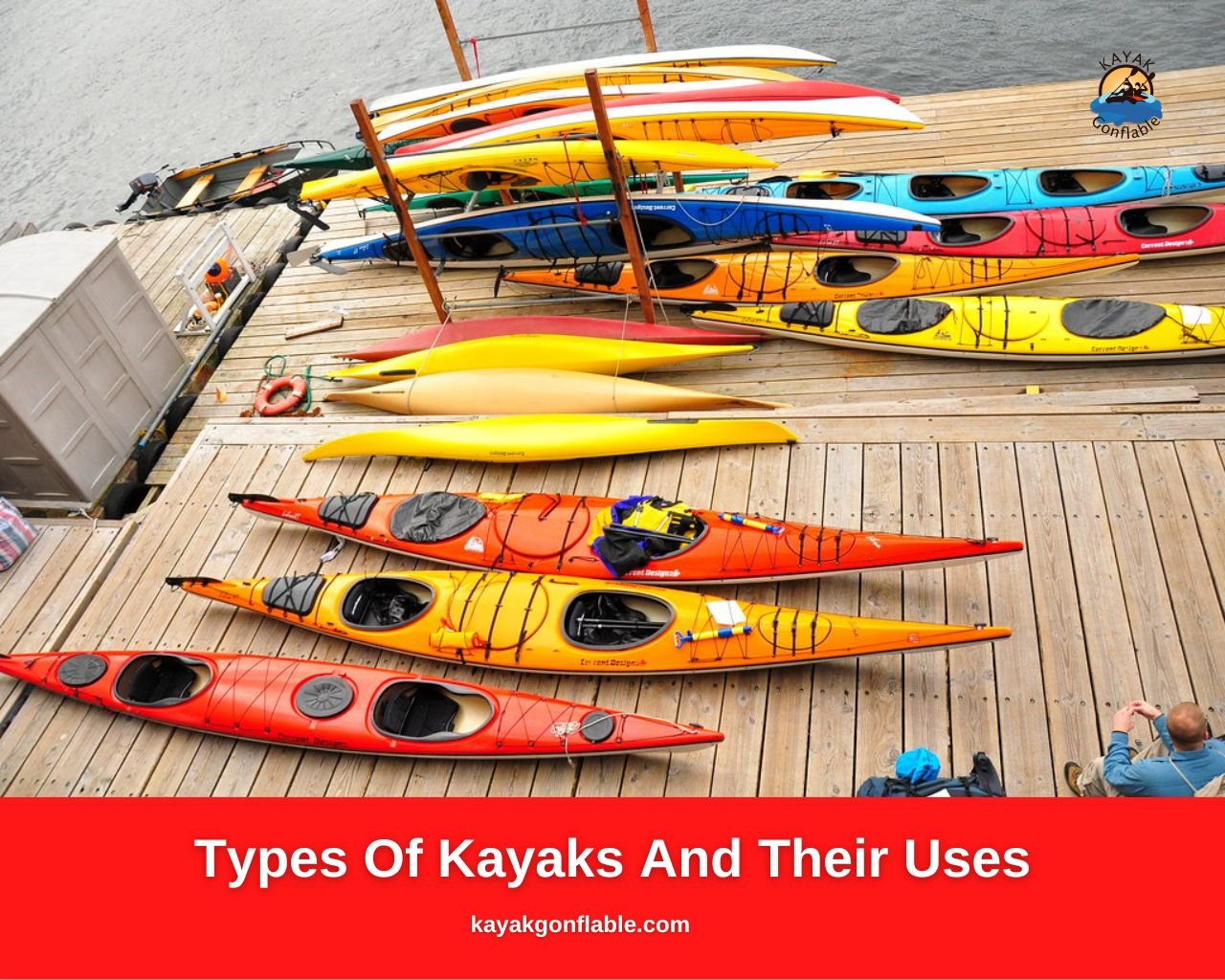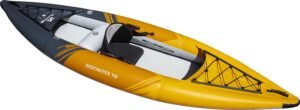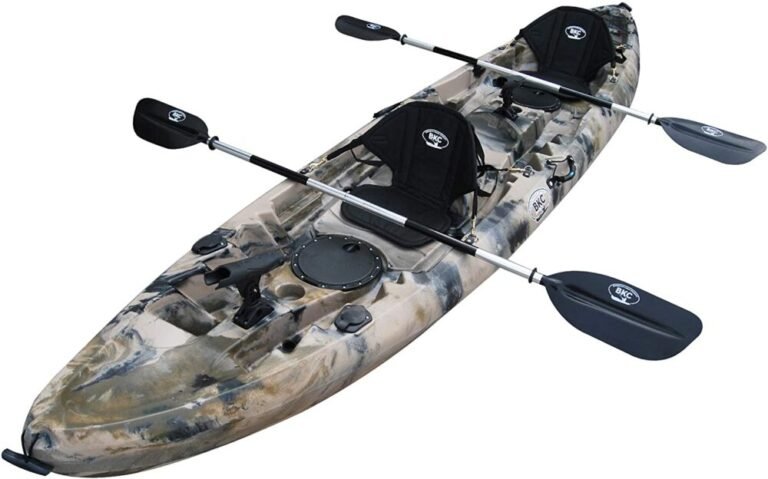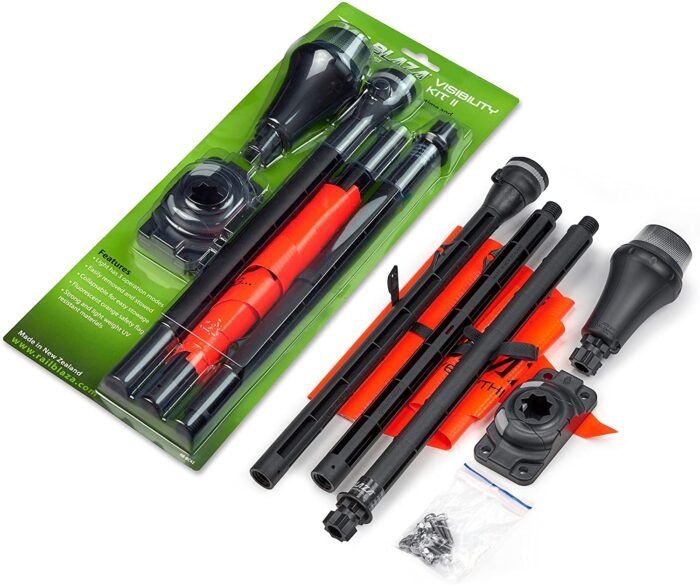Different Types Of Kayaks And Their Uses

Kayaking is a great way to explore nature and enjoy the great outdoors. However, before you can kayak, you need to know about the different types of kayaks and their uses especially if you are a novice and want to purchase a kayak of your own.
Knowing the different types of kayaks and their capabilities will help you make the right choice in kayaks for optimum fun on the water. There are three main types of kayaks: recreational kayaks, touring kayaks, and racing kayaks.
Recreational kayaks are designed for leisurely paddling around lakes or rivers. Touring kayaks are designed for more exploration, with longer decks and greater cargo capacity. Racing kayaks are designed for speed.
They have longer and narrower hulls and more pronounced deck lines. Racing kayaks are used in the sport of whitewater kayaking and the many different types of races.
While those are the main types of kayaks, kayaks can be classified based on other things with some kayaks best suited to an activity (fishing kayaks exist for fishing), while others are most suited to a waterbody (sea kayaks are best used in sea and ocean travel).
This article helps you gain knowledge on the different types of kayaks and their uses to aid you in making an informed choice when getting a kayak of your own.
Types Of Kayaks Based On Style
Kayaks come in different shapes and sizes but they can all be classified into two main groups based on their cockpit styles.
Kayaks with an open cockpit design are called sit-on-top kayaks while those with a closed cockpit and a seat are called sit-in kayaks. These two categories of kayaks are explained below.

Sit-On-Top Kayaks
Sit-on-top kayaks are perfect for those who want the convenience of a kayak but don’t want to be constrained by a seat or cockpit. These kayaks are typically shorter in length and wider than traditional kayaks making them perfect for calm waters.
They come with open cockpits that allow you to sit back and enjoy the scenery while paddling. They also have more open decks than traditional kayaks, which means you have more space to store your belongings and sit comfortably.
They are also an excellent choice for families and novice paddlers. Sit-on-top kayaks are a great way to get out on the water, without having to waste your time getting in and out of a traditional kayak.
They’re also great for people who have trouble getting into or out of kayaks because of their height or disability. With sit-on-top kayaks, you simply sit down on the kayak and enjoy the paddling experience.
Pros Of Sit-On-Top Kayaks
Sit-on-top kayaks offer a unique experience that can’t be found in other types of kayaks. Their advantages include:
- They are easy to get into and out of, making them perfect for novice kayakers.
- Sit-on-top kayaks are versatile and can be used for a variety of activities, including fishing, touring, and recreation. They are especially popular in fishing.
- Sit-on-top kayaks come with built-in scupper holes to help drain any water that gets into the kayak while paddling and that helps prevent swamping. The scupper holes also come in handy when locking the kayak as they provide a convenient place to run a cable loop through.
- The lack of a cockpit offers paddlers on sit-on-top kayaks more mobility than their sit-in kayak counterparts as you can for instance easily stand up in a sit-on-top kayak.
- Sit-on-top kayaks are great for:
- Kayaking in calm waters.
- Kayaking in small ponds, lakes, and rivers.
- Kayaking with kids.
Cons Of Sit-On-Top Kayaks
- Sit-on-top kayaks are heavier than traditional kayaks, so they’re harder to transport and portage.
- Sit-on-top kayaks are not as stable as traditional kayaks making them less comfortable for extended trips. If you’re not used to this type of kayaking, it can be difficult to stay balanced while paddling.
- These kayaks are not typically designed for rough water.
- They can be difficult to maneuver in tight places.

Sit-In Kayaks
Sit-in kayaks are a unique form of watercraft that allow users to stay seated in the vessel while paddling.
They are often compared to sit-on-top kayaks, but sit-in kayaks have a slightly different design that allows the user to rest their entire body instead of just their legs.
This unique design makes sit-in kayaks more comfortable and easier to use than traditional kayaks. Sit-in kayaks are specifically made for people who want to sit in them instead of standing up.
They’re also much easier to maneuver than traditional kayaks as they have greater stability and that makes them perfect for beginners.
Sit-in kayaks are fitted with seats that could be removable or non-removable in their enclosed cockpits for the kayaker to sit comfortably while paddling on the water.
The seats vary based on the kayak with some having elaborate seats like recreational and fishing kayaks while others have plainer seats. The seats typically have backrests for increased comfortability.
Sit-in kayaks are also a good choice for paddlers who want to bring along pets or small children, as they offer more protection from the elements than a traditional kayak.
Pros Of Sit-In Kayaks
- Sit-in kayaks are a great option for beginner and experienced kayakers alike.
- They provide a high level of stability and are easy to maneuver.
- Sit-in kayaks also offer great protection from the elements, making them perfect for cold weather paddling or extended trips.
- Another great feature of sit-in kayaks is that they often have more storage capacity than other types of kayaks.
- Sit-in kayaks are often faster than their sit-on-top counterparts because they have a smaller, more aerodynamic profile.
Cons Of Sit-In Kayaks
- Sit-in kayaks can be difficult to get in and out of, especially if you are not very flexible.
- Getting in and out of a sit-in kayak can also be difficult if you are not very coordinated.
- Sit-in kayaks offer less mobility to the paddler as he sits in the watercraft with his legs beneath the deck.
- The paddler has to exercise caution so as not to get swamped while paddling and in the event of a capsizing.
- They can be difficult to maneuver in windy conditions and choppy water.
Types Of Kayaks Based On Activities
Generally, all kayaks are either sit-on-top or sit-in kayaks. They can however still be further classified based on the activity they are used for. The types of kayaks based on activities are explained below.

Recreational Kayaks
Recreational kayaks are often smaller than other types of kayaks making them more portable. They’re designed for calm waters and easy maneuverability, making them perfect for a leisurely paddle on a lake or slow-moving river.
Most recreational kayaks have open cockpits, which makes them unsuitable for rough waters. Recreational kayaks are designed for comfort and easy paddling.
They are typically wider and shorter than other kayaks, which makes them more stable. They also have a large deck area, which is great for sunbathing or fishing.
The primary purpose of recreational kayaks is to get people out on the water as often as possible, whether they are looking for a workout or just want to enjoy nature. The price of these kayaks varies, but you can typically find them for under $200.
Recreational kayaks are not built for speed and are typically 10 feet long. They are typically made of lightweight materials like plastic or fiberglass.
Recreational kayaks are the most popular type of kayak and are also well-suited for paddlers of all ages, experiences, and skills. Recreational kayaks can be used for fishing, bird watching, or simply relaxing on the water.
Examples of recreational kayaks include Sea Eagle 380X Explorer, Old Town Vapor 10, and Perception Pescador 10.

Sea Kayaks
Sea kayaks are a type of kayak that is designed specifically for use in the open water, as opposed to whitewater, flat water, rivers, or lakes.
They are longer and narrower than other kayaks, with a pointed bow and stern, which makes them better suited for crossing open water.
They typically have a covered deck and a watertight hatch that allows you to store supplies in the kayak. Sea kayaks also have a rudder system that allows you to control the direction of the vessel.
Sea kayaks are typically used for touring and long-distance expeditions and they can be equipped with a variety of accessories, including navigation aids, fishing gear, and storage compartments.
Examples of sea kayaks include Wilderness Systems Tempest 170, Perception Expression 15, and Eddyline Fathom.

Touring Kayaks
When most people think of kayaking, they imagine leisurely paddling down a placid river on a bright summer day.
However, kayaks are also perfect for touring – a style of kayaking that involves covering long distances in open water, and the type of kayaks designed for that is known as touring kayaks.
Touring kayaks are sometimes called sea kayaks. A touring kayak is a type of kayak that is designed for long-distance trips. They are typically more stable and have a larger cargo capacity than other types of kayaks.
This makes them ideal for camping trips or extended paddling excursions. Touring kayaks can be either sit-in or sit-on-top models, and they often have a rudder system to help with steering so they can be used in even the most challenging conditions.
Touring kayaks also have a keel that helps them track in a straight line, making it easier to paddle long distances. Touring kayaks are often very stable, but they can be heavy, which is one of the reasons why they aren’t very popular for recreational use.
Touring kayaks are a great option for those looking for a versatile watercraft that can handle a variety of conditions. They are typically longer and narrower than other types of kayaks, making them faster and more efficient when paddling long distances.
They are also built to handle rough conditions and heavy seas, making them great for ocean sailing or touring. Touring kayaks also tend to have a more spacious cockpit than other types of kayaks, making them comfortable for extended trips.
The hull of this kayak type is made of light materials such as foam, fiberglass, and polyethylene to make them affordable while providing a sturdy and comfortable ride.
Examples of touring kayaks include Eddyline Fathom, Delta 16, and Eddyline Equinox.
Sea Kayaks Vs Touring Kayaks
Though sometimes used interchangeably, there is a slight difference between these two terms.
Sea kayaks are specifically designed for use in seas and oceans whereas touring kayaks are designed for long paddling trips on the open water which is not necessarily the sea.
The two kayak types are thus often the same but sometimes, the manufacturer may design the kayak specifically for use in the sea (usually by making the hull fit for the sea waves with the remaining parts being the same) thus making it different from touring kayaks
Some differences between these two kayak types are given below.
- Sea kayaks are shorter and wider than touring kayaks.
- Sea kayaks are designed for paddling in rougher water, so they have more rocker (curvature of the hull) than a flat bottom. This makes them more maneuverable but also less stable than touring kayaks.
- Sea kayaks are designed for coastal and ocean use while touring kayaks are designed for inland and flat water use.
- Touring kayaks are longer and narrower than sea kayaks, with a more pronounced keel. They are designed for paddling in calmer waters and are more stable but less maneuverable.
- Sea kayaks also tend to have deeper cockpits than touring kayaks.
- Since they have more rocker, sea kayaks can cut through waves more easily than touring kayaks.

Fishing Kayaks
Since time immemorial, one of the primary reasons man was found on or near the water was to fish. It is thus very natural for kayaks designed specifically to catch fish to exist.
A fishing kayak is a type of kayak that is specifically designed for anglers. These kayaks have features that make them ideal for fishing, such as rod holders, pedal propulsion systems (that are sometimes motorized), mounts for electronic devices, and storage for tackle and bait.
They are also wider and slower than traditional kayaks, making them more stable in the water. This makes them perfect for anglers who want to get up close to their catch.
Some kayaks are designed specifically for fishing, while others can be used for both fishing and other activities. Some anglers prefer a sit-on-top kayak while others prefer a more traditional kayak.
If you want to fish from the shore, you will want to check out a fishing kayak that has an easy-to-remove center console compartment and forward deck storage.
Fishing kayaks tend to be very heavy as they have additional features to facilitate fishing and space to accommodate your catch.
If you fish once in a while, you may not need a fishing kayak and can make do with a recreational kayak with additional features like a rod holder. If your main purpose on the water is to fish however you should buy a fishing kayak right off the bat.
Examples of fishing kayaks include Argo 100XP Angler, Topwater 120 PDL, and The Catch 110 HyDryve II.

Whitewater Kayaks
Whitewater kayaks are a specific type of boat that is designed for use in moving water. They are shorter than traditional kayaks, which makes them more stable in rough conditions. Whitewater kayaks also have a variety of features that allow them to handle rapids and other obstacles.
Whitewater kayaks are vessels specifically designed for navigating whitewater rivers that is they are specially designed for racing, navigating rapids, and other challenging waterways.
They are narrower and shorter than other kayaks, with a pointed bow and stern that allows them to carve easily and quickly through the water.
Whitewater kayaks also have a higher center of gravity, which gives them more stability in fast-flowing water. Most whitewater kayaks are made from fiberglass or plastic, but some are made from wood or other materials.
As whitewater kayaking is dangerous, the sport is reserved for paddlers with experience who can handle themselves in tricky situations. Most whitewater kayaks are designed for use by one person, but some are designed to be used by two people.
Types Of Whitewater Kayaks
Whitewater kayaks exist for navigating rapids and other whitewater conditions. As such, different whitewater kayaks exist for handling different whitewater conditions.
There are four main types of whitewater kayaks namely: longboats, creek boats, river runners, and playboats.
Longboats
Longboats are a type of whitewater kayak that has a longer, more slender hull than other kayaks. This makes them faster and better able to handle rapids, but they are also more difficult to maneuver.
They are thus ideal for straight races with no need for tight turns. Longboats are popular with experienced kayakers who are looking for a challenge and are designed specifically for racing and moving swiftly in tricky terrain.
Navigating longboats takes a lot of strength so while they provide a great workout for the upper body, they can be difficult to handle once you get tired.
Longboats are ideal for racing and expeditions not only for their speeds but also for their storage space enabling you to bring enough gear for an extended stay on the water. Longboats also have a lot of stern rockers to help them move fast in rapids.
Creek Boats
Creek boats are a type of whitewater kayak that are designed to handle rapids and obstacles that are found in creeks.
They have a short (7.5 to 9 feet), wide design that makes them stable and easy to maneuver in tight spaces, which is why they are popular for creek running.
Creek boats usually have a rounded bottom (they have a strong rocker), which helps them stay on top of the water and prevents them from getting stuck in rocks.
They also come with a variety of features that allow you to customize your ride, such as adjustable foot pedals and thigh braces.
Because of their design, creek boats can go where other kayaks cannot, making them a popular choice among whitewater enthusiasts. Examples of creek boats include Mamba 8.6, Mamba 8.1, and Jed (L).
River Runners
River runners are a type of whitewater kayak that is designed for speed and agility on whitewater rapids. They are shorter (7 to 9 feet) and narrower than other kayaks, which gives them more stability on fast-moving water.
River runners are also equipped with a variety of attachments that allow them to navigate through tight spaces and around rocks. This makes them perfect for tackling difficult whitewater rapids.
River runners are a type of whitewater kayak that is designed for running rivers. River running is a sport that involves paddling down a river in a controlled manner to experience the rush that comes with paddling in quick-moving water.
River runners often have a flat bottom and a blunt nose, which makes them more stable in rapids. They are also typically equipped with a spray deck to keep the paddler dry.
River runners are generally easier to paddle than other types of kayaks, but they can be more difficult to turn and maneuver in flat water. They are also less suited for open water or ocean kayaking.
Examples of river runners include Nirvana Large, Katana 10.4, and Fusion (S).
Playboats
Kayaks have been around for centuries and have been used for a variety of purposes. Whitewater kayaks are specifically designed for navigating through whitewater rapids.
There are several different types of whitewater kayaks but an interesting one is playboats. Playboats are specifically designed for performing tricks, stunts, and aerial moves in small to medium-sized rapids.
In other words, they are designed for the kayaker to have fun in exhilarating conditions. Compared to other kayaks, playboats are shorter (less than 6.5 feet) and more rounded, with a wider beam and less volume.
This makes them more maneuverable but also less stable. Playboats typically have more rocker, or curvature, in the bow and stern, which allows them to spin quickly and easily.
Playboats also typically have a lot of volume in the bow and stern, which allows them to stay on top of the water even when they are upside down. This makes them ideal for performing tricks and stunts.
Some movements with playboats include lateral and backward movement, rotations, and dunking the vessel’s nose into the water on purpose.
As playboats are for performing tricks, they can only be used by experienced paddlers in technical locations so they are not always seen on the water. Examples of playboats include Nirvana medium, Remix 47, and Jitsu 5.5.

Inflatable Kayaks
Inflatable kayaks are a newer type of kayak that has been growing in popularity in recent years. They are made of an inflatable raft material (usually rubber and vinyl or PVC material) with a rigid frame and come in a variety of shapes and sizes.
They are the most common type of kayak and are basically normal kayaks that can be deflated when not in use.
Inflatable kayaks are a great option for people who want the experience of kayaking but don’t have the space for a traditional kayak or the money for a hard-shell kayak.
Inflatable kayaks are also good for people who are new to kayaking and want to try it out before investing in a traditional kayak. Inflatable kayaks can be deflated and folded for easy transport. They can also be stored in a small space when not in use.
Examples of inflatable kayaks include Advance Elements AdvancedFrame, Isle Switch SUP & Kayak, and Intex Explorer K2.
Surf Kayaks
Surf kayaks have been growing in popularity for the last few years. This is because they offer a unique experience that can’t be found with other types of kayaks.
Surf kayaks are designed to catch waves and ride them, just like a surfboard. They are typically longer and narrower than other kayaks and have a pointed nose that allows them to cut through the waves more easily.
Surf kayaks can be either sit-on-top or sit-in models, and are often equipped with fins and other surf accessories to help riders catch waves. Surf kayaks have a lot of volume, which makes them more stable in the water.
They are often made out of fiberglass or carbon fiber, which makes them lightweight and durable. Surf kayaks also have adjustable footpegs and seats, which makes it easier to get up on the board.
They have a pop-up skeg on the bottom of the hull that allows it to track better in rough water.
They are also easy to paddle when the waves are up, which makes it easier to catch waves.
Surf kayaks have a lot of storage space in the nose, which is great for carrying things you need while surfing.
Examples of surf kayaks include Sun Dolphin Bali SS 10-Foot Sit-on-top Kayak, Sun Dolphin Aruba SS 10-Foot Sit-in Kayak, and Lifetime Muskie Angler Sit-on-top Kayak.

Tandem Kayaks
Kayaking is a great way to get out and enjoy nature. It is also a great form of exercise. There are many different types of kayaks available on the market, and each has its own unique set of features.
One type of kayak is the tandem kayak (two-person kayak). Tandem kayaks are great for beginners as they offer a great way to get started because they are more stable and offer more support than traditional kayaks.
They are also a great option for those who want to share their kayaking experience with a friend or family member. Tandem kayaks come in a variety of shapes and sizes, so you can find one that’s perfect for your needs.
It is important to keep in mind that if you are paddling with a partner, synchronizing your paddle strokes is crucial to prevent the paddles from colliding with each other every so often.
This is because the space between the two cockpits of most tandem kayaks is not that much thus increasing the chances of the paddles colliding and the watercraft being off-balanced. You should thus take care to coordinate your strokes with your partner.
Another crucial thing to note is that while uncommon, kayaks sometimes capsize, and that due to having two paddlers in the vessel, it could be harder to recover.
You should keep this in mind before going kayaking especially if you will be going through rough or choppy waters and ensure you and your partner can handle yourselves on the water.
Examples of tandem kayaks include The Intex 68310VM Dakota K2, Intex Excursion Pro, and Wilderness Systems Pamlico 135.
Beginner Types Of Kayaks
There are all sorts of kayaks for all sorts of people. The best kayak for a beginner is usually a recreational kayak. These kayaks are stable and easy to use, making them perfect for novices.
There are, however, different types of recreational kayaks, so it’s important to choose the right one.
Before making a choice, it is smart to go to a local kayaking club in your neighborhood to have some experience with different kayaks and decide which one suits your personality best.
You may want a sit-inside or sit-on-top kayak, and a rigid or inflatable kayak depending on which kayak you desire, where you intend to use it, and how much you are willing to spare.
Some examples of kayaks for beginners include:
- Sun Dolphin Bali SS 8-Foot Sit-on-top Kayak
- Intex Challenger K2 Kayak
- Perception Pescador Pro 12
- Intex Explorer K2 Kayak
- Lifetime Youth 6 Feet Wave Kayak
There are many different types of kayaks and each has its own unique set of uses. It is important to know which kayak is best for your needs so that you can have the best possible experience on the water.
Whether you’re looking for a leisurely paddle around a calm lake or an adrenalin-pumping white-water adventure, there’s a kayak out there that’s perfect for you!
If you are a beginner, it is recommended that you start with a recreational kayak, which is stable and easy to maneuver.
Once you have gained some experience, you may want to consider upgrading to a more specialized model. Always employ safe practices while kayaking.





